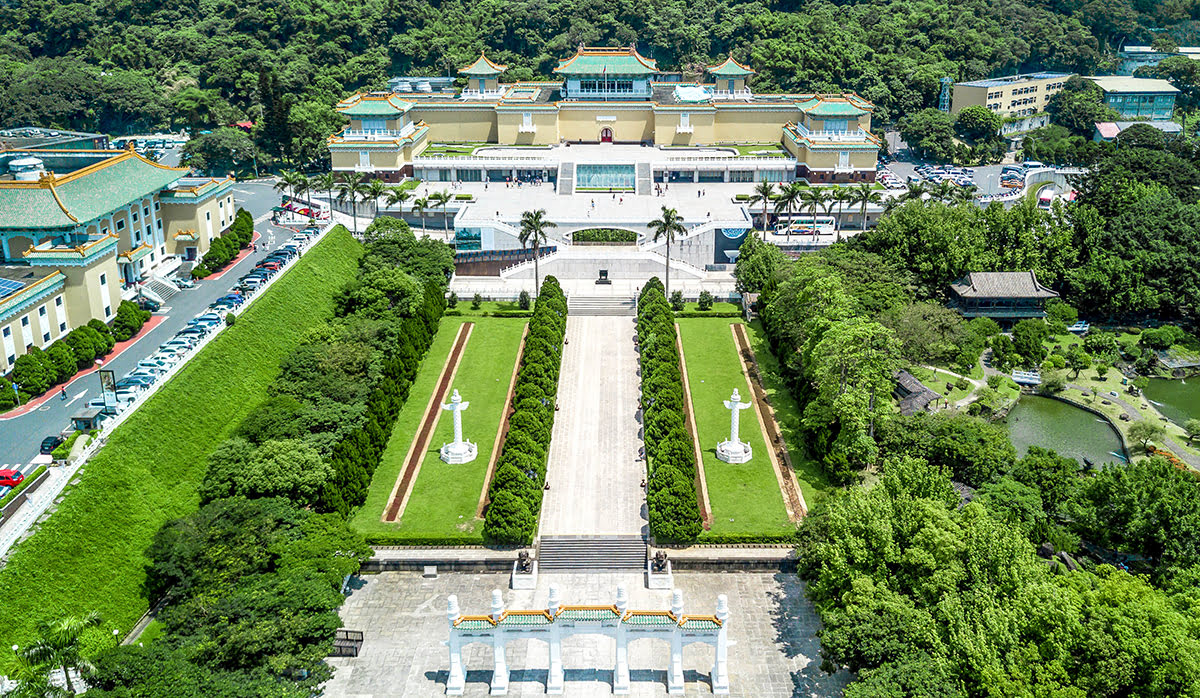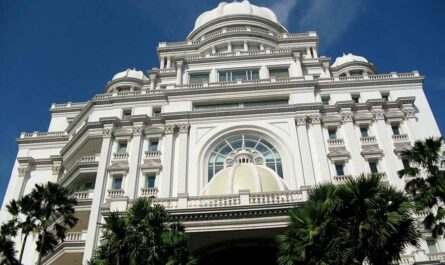Nestled in the heart of Taipei, Taiwan, the National Palace Museum stands as a venerable repository of Chinese cultural heritage, spanning a breathtaking chronology from the Neolithic period to the modern era. This venerable institution is an embodiment of artistic and historical grandeur, captivating the minds and hearts of visitors with its vast collection of Chinese artwork and antiquities. The rich tapestry of this museum’s exhibits weaves together the intricate threads of China’s enduring history and artistic prowess. In this article, we will explore some interesting information about the National Palace Museum. Keep reading.
A Glimpse into the Crown Jewel of Taiwanese Museums
Regarded as one of Taiwan’s most celebrated cultural institutions, the National Palace Museum, affectionately known as NPM, boasts an unparalleled and dazzling collection of Chinese artistry. Within its hallowed halls, the museum houses an eclectic assemblage of precious artifacts that span the entirety of China’s storied past. From the mesmerizing Jade cabbage, a symbol of fertility and prosperity, to historic statues carved with unparalleled skill, and the timeless elegance of bronze creations, the museum’s holdings are nothing short of breathtaking.
The National Palace Museum stands as a veritable treasure trove of religious content, encompassing the spiritual and divine dimensions of Chinese culture. Through a meticulous curation process, the museum’s display has been carefully crafted to offer visitors an extraordinary visual and intellectual feast. Its exhibits transcend the boundaries of mere historical artifacts and transform into a mesmerizing narrative, inviting visitors to delve into the rich tapestry of China’s profound artistic and cultural heritage.
National Palace Museum Interesting, Fun Facts
Many individuals often find themselves mistakenly associating the National Palace Museum with its counterpart in Beijing. Nevertheless, these two esteemed institutions are now distinctly separated, each preserving its unique collection and cultural legacy. Below is some interesting information about the National Palace Museum that you probably don’t know.
1. Historical Background and Dispersal of Collections
In the tumultuous era of the 1930s, the Japanese invasion of North China sent shockwaves throughout the Chinese cultural landscape. Faced with the looming threat, the Chinese government took the extraordinary step of relocating a significant portion of the illustrious Palace Museum’s treasured holdings. These invaluable artifacts embarked on a journey, first finding temporary refuge in Nanjing, and later being transported to the bustling metropolis of Shanghai, among other locations. However, the end of World War II brought about a turning point.
The dispersed collections were painstakingly reassembled in the city of Nanjing. But, history had another chapter to write, as the turbulent years of 1948-49 witnessed the dramatic relocation of these precious cultural treasures by the retreating Nationalist armies to the island of Taiwan. For over a decade, they found a sanctuary in the Taipei suburb of Taichung, patiently waiting for their ultimate destination. Finally, in the year 1965, these irreplaceable artifacts found their permanent residence, adorning the Palace Museum in Taiwan, becoming an integral part of its rich heritage.
2. Diverse and Rich Historical Range
The Palace Museum’s historical range is nothing short of awe-inspiring. This esteemed institution boasts an unparalleled collection that spans a multitude of categories, each more captivating than the last. Take ceramics, for instance. Within this singular category, one is transported through the annals of time, as these exquisite pieces hail from numerous dynasties, extending their origins even further to the depths of Neolithic antiquity. The museum’s comprehensive and diverse holdings offer visitors a breathtaking journey through China’s profound cultural and artistic evolution, unraveled through the prism of its remarkable ceramic treasures.
3. A Museum of the Modern Age
The Palace Museum is not merely a repository of historical artifacts frozen in time. It epitomizes the essence of a fully modern museum, seamlessly blending the rich tapestry of the past with the cutting-edge technologies of today. This institution is actively engaged in Taiwan’s National Digital Archives Program, embracing the forefront of digital innovation to meticulously preserve its precious historical artifacts for posterity.
Not content with resting on its laurels, the Palace Museum leverages state-of-the-art technology to enhance the visitor’s experience, making it an educational and immersive journey into China’s cultural heritage. This juxtaposition of ancient treasures and modern innovation creates a unique, multifaceted institution, where the past meets the future, ensuring that the legacy of Chinese culture endures, enriched by the marvels of technology.
4. Enhancing Visitor Experience and Preserving History
The Southern Department of the National Palace Museum (NPM) experienced a considerable influx of approximately 1.04 million guests in 2019, setting an impressive precedent for the institution. Looking ahead, the museum is fervently determined to surpass this record in the current year. The director of this esteemed institution, Director Peng Tzu-cheng (彭子程), has outlined a strategy to attract a broader audience by unveiling some of the museum’s most cherished ancient relics.
In the year 2020, the National Palace Museum is set to mesmerize its visitors with a curated selection of historically significant exhibitions. Notable among these displays are the “Jadeite Cabbage with Bugs” and the “Jade Pi-Hsieh” sculpture, both of which have their roots tracing back to the Eastern Han Dynasty, a period stretching from 25 AD to 220 AD. These treasures, etched with historical significance, promise to transport visitors on a captivating journey through the annals of time, revealing the artistic prowess and craftsmanship of ancient civilizations.
5. Diverse Treasures in Abundance
The National Palace Museum, nestled in the heart of Taipei, Taiwan, is a veritable treasure trove, boasting an extensive and awe-inspiring collection that spans a multitude of artistic disciplines. This esteemed institution is renowned not only for its remarkable Chinese ritual bronzes but also for its vast assemblage of ceramics, exquisite jade artifacts, resplendent lacquerware, intricately crafted enamelware, ornamental carvings that are nothing short of masterpieces, mesmerizing embroidery and tapestry, priceless books that chronicle the rich history and culture of China, the art of calligraphy at its finest, and an extensive collection of archival documents that offer invaluable insights into the annals of time. Each of these categories, a treasure chest in its own right, contributes to the museum’s status as a cultural sanctuary of unparalleled significance.
6. Bridging the Past and Present through Animation
In 2011, the National Palace Museum embarked on a pioneering endeavor that illuminated the intersection of art and technology. This visionary institution introduced the Continuous Portray Animation exhibition, a groundbreaking initiative that breathed life into timeless artworks. Six iconic masterpieces were meticulously chosen for this project, and through cutting-edge technology, they were transformed into full-scale, dynamic animations. Among these cherished pieces, the celebrated “Along the River Through the Qingming Festival” stands as a mesmerizing testament to the fusion of tradition and innovation. This technological marvel not only captivated the imagination of visitors but also succeeded in bridging the gap between the past and present, offering a unique perspective on the artistic heritage of China.
7. Unlocking the Museum’s Global Reach
The National Palace Museum, with its rich repository of cultural treasures, has expanded its influence far beyond the borders of Taiwan. The digital collection, a monumental archive boasting over 690,000 items, has been aptly named the “New Waves of NMP Travelling Exhibition.” This digital treasury is more than a passive archive; it is a dynamic platform that empowers international institutions to partake in the cultural riches the museum has to offer. Through this innovative initiative, artworks that would otherwise remain ensconced within the museum’s walls find their way to various corners of the globe, breaking down geographical barriers and allowing a global audience to appreciate and learn from the depth and breadth of China’s artistic heritage.
8. An Ambitious Renaissance: Expansion and Transformation
In a grand vision of renewal and expansion, the National Palace Museum launched an ambitious project aimed at not only expanding the exhibition space but also revitalizing the museum’s physical environment. The official inauguration of this transformative undertaking took place in the vibrant city of Taipei. The heart of this endeavor rests upon a substantial budget, estimated to be in the range of 10 to 12 billion New Taiwan Dollars.
With this significant financial investment, the museum seeks to transcend its current confines and reemerge as a cultural bastion that can accommodate the ever-growing fascination with the art and history of China. This renovation promises to provide a fresh canvas upon which the past, present, and future of this remarkable institution can harmoniously coexist, ensuring its continued legacy for generations to come.

9. A Treasure Trove of Antiquity: The National Palace Museum
Nestled within the heart of Taiwan’s cultural landscape lies the National Palace Museum, an awe-inspiring haven of knowledge and historical riches. This remarkable institution boasts an immense collection of archaeological artifacts, historical relics, metaphorical treasures, and invaluable national heirlooms, which have been lovingly preserved for the enrichment of Antiochians and the world at large. Among its most prized possessions, the museum is home to the cherished national treasures once held by the imperial family. These treasures are a testament to the rich heritage and cultural tapestry that defines Taiwan’s history.
10. The Eloquent Passage of Time: 95 Years of Legacy
As the National Palace Museum approaches its 95th anniversary, it stands as a testament to the enduring legacy of culture and history. The year 1925 marked its inception, a time when it was conceived to be a sanctuary of knowledge and preservation. However, it was in 1965 that the museum truly came into its own. This milestone year witnessed the amalgamation of collections from Taiwan’s Nationwide Palace Museum, the Central Museum, and several other esteemed public cultural institutions. This convergence led to the establishment of a magnificent new museum building in Taipei, solidifying the National Palace Museum’s status as a cultural icon.
11. Sibling Museums Born of Division: A Tale of Two Palaces
The National Palace Museum and the Palace Museum within Beijing’s Forbidden City may not be the same, but their roots share a remarkable connection. These two prestigious institutions were once part of a single entity, an illustrious museum with an intertwined past. However, the cataclysmic forces of the Chinese Civil War divided them into two distinct museums. Originally, the National Palace Museum was founded within the hallowed walls of the Forbidden City. It was a place where ancient treasures and cultural gems thrived. Yet, the tides of history dictated otherwise, leading to its relocation to the custody of the last emperor of China.
12. A Glimpse into History at the Forbidden City
The illustrious National Palace Museum, housing these priceless artifacts, is situated within the hallowed grounds of the Forbidden City. The Forbidden City, a paragon of Chinese imperial architecture, encapsulates the rich cultural heritage of China, spanning from the Ming Dynasty through to the conclusion of the Qing Dynasty. This architectural marvel, replete with opulent courtyards, intricate palaces, and sprawling gardens, represents a testament to China’s regal history.
Elevating its status further, the Forbidden City secured a place on the prestigious list of UNESCO World Heritage Sites in 1987. It boasts an unparalleled distinction as the world’s most extensive compendium of exquisitely preserved ancient wooden structures. Visitors to this extraordinary locale are bestowed with the privilege of witnessing an awe-inspiring ensemble of historical treasures in an architectural setting that exudes grandeur and reverence, solidifying the Forbidden City’s position as an epicenter of cultural significance.
13. The National Palace Museum: A Treasury of Ancient Chinese Artifacts
The National Palace Museum stands as an illustrious beacon of the vast and invaluable reservoir of ancient Chinese artifacts, a veritable treasure trove that beckons both the curious and the connoisseurs of history and art. It boasts the unparalleled distinction of housing the largest collection of these timeless relics, which hail from various corners of the world. A staggering 700,000 pieces of ancient Chinese imperial artifacts, complemented by a splendid array of artworks, are nestled within the hallowed halls of this venerable institution.
This prodigious collection spans a wide spectrum of artistry and craftsmanship, encompassing a rich tapestry of painting, calligraphy, statuary, bronzes, lacquerware, ceramics, jade, and religious objects. The diversity and breadth of the collection leave no stone unturned in exploring the multifaceted beauty of Chinese culture and history. Noteworthy, however, is the regular rotation of display pieces, each changing approximately once every three months. Such a meticulous curation strategy is a testament to the sheer magnitude of the museum’s offerings, for it implies that a dedicated patron, eager to immerse in the entirety of this prestigious museum’s treasures, would require a staggering twelve years to explore it all.
14. The Southern Branch: A Shimmering Jewel of Cultural Diplomacy
In the year 2004, the National Palace Museum embarked on an ambitious endeavor, one that would mark a pivotal chapter in its history and augment its influence beyond its island home. This visionary pursuit was none other than the establishment of the southern branch of the museum, situated within the bounds of mainland China. Today, this branch stands as a fully-fledged and resplendent counterpart to its northern sibling, welcoming an ever-increasing throng of art enthusiasts and cultural aficionados, both from the local community and abroad. Buy Textbooks. Sell Textbooks. eTextbooks. Most Used Textbooks On the Planet. 10 million books. 50% Cash Back Books. FREE Shipping
The intriguing motivation behind this expansion is not without conjecture. It is widely believed that this strategic move was aimed at enhancing Taiwan’s international visibility, thus strengthening its global identity. By extending its cultural reach across the Taiwan Strait, the National Palace Museum has transcended the limitations of political boundaries, echoing the universal language of art and history.
15. “The Three Treasures”: A Culmination of Artistic Splendor
Among the myriad gems in its collection, one particular trio shines with a truly peerless luster. This triumvirate of treasures includes a 100-year-old Jadaiti cabbage, a layered stone-carved pork chop, and a bronze cauliflower crafted under the patronage of Duke Mao. These three artifacts have collectively earned the distinguished title of “The Three Treasures” of the National Palace Museum, and they are celebrated as cultural icons that epitomize the museum’s rich and diverse offerings.
The Jadaiti cabbage, in its intricate and lifelike representation, captivates with its exquisite detail and symbolic significance. The stone-carved pork chop, with its artful layers and textures, offers a tantalizing blend of aesthetic and culinary sensibilities. Meanwhile, the bronze cauliflower, attributed to Duke Mao, stands as a testament to the mastery of bronze craftsmanship in ancient China. These three treasures encapsulate the essence of the museum, showcasing not only the artistic virtuosity of the past but also the enduring allure of these remarkable artifacts. Ticket for Events
16. Surge in Museum Visitors
In recent years, the National Palace Museum has witnessed a remarkable surge in the number of patrons gracing its halls. The statistical evidence of this phenomenon is nothing short of astounding, with the visitor count last year having reached an impressive milestone of 3 million. This meteoric rise in attendance, however, has ushered in a set of challenges about security and crowd management. Consequently, the National Palace Museum has instituted a rigorous system of visitor control, ensuring that the number of individuals within its hallowed precincts remains consistently under the threshold of 20. This proactive approach not only safeguards the priceless artifacts and artworks housed within but also ensures that each visitor’s experience is elevated to a level of unrivaled quality.
17. A Contemporary Approach to Preservation
The National Palace Museum stands as a paragon of contemporary museums, seamlessly blending the past with the cutting-edge technologies of the present era. As a testament to its commitment to preserving cultural heritage, the museum actively participates in Taiwan’s National Digital Archive Program. This collaboration serves as a powerful conduit through which the institution harnesses the latest digital technology to perform the invaluable task of digitally conserving its extensive collection of antiques and art pieces. The overarching objective of this monumental effort is to enhance the overall experience of the museum’s diverse and discerning audience. By embracing the digital frontier, the National Palace Museum not only safeguards its heritage but also extends its reach, offering patrons a unique and immersive encounter with the annals of history. Women’s health, pregnancy, supplements, breastfeeding
18. The Allure of Jade: A Timeless Treasure
One of the most revered treasures within the sprawling tapestry of the Taipei National Palace Museum’s collection is the mesmerizing world of jade. Its popularity transcends time and cultural boundaries, an effervescent testament to its remarkable antiquity and sheer rarity. This particular masterpiece has cast a spell on art enthusiasts and historians alike, its beguiling charm emanating from the intricate craftsmanship and deep historical significance it embodies. As patrons traverse the museum’s galleries, their gaze inevitably gravitates toward these enchanting jade artifacts, where history and artistry intertwine to create an aura of unparalleled allure.
19. The Magnificent Tapestry of Chinese Art
The National Palace Museum’s collection paints a vivid tapestry of over 4,000 years of Chinese art, a repository of culture and creativity that captures the essence of a rich and storied civilization. In the realm of Chinese paintings, the institution’s vintage collection stands as a beacon of global recognition, acclaimed as the finest of its kind in the world. This awe-inspiring assemblage boasts an array of masterpieces spanning the Tang, Song, Ming, and Qing dynasties, each a testament to the artistic prowess of their respective eras. Beyond paintings, the National Palace Museum’s treasury extends its benevolent reach to encompass a plethora of other noteworthy artifacts, ranging from the hallowed bronze artifacts used in ancient Chinese rituals to the delicate ceramics that adorn imperial courts.
The exquisite luster of jade, the intricate beauty of lacquered enamelware, and the enchanting world of decorative engraving further enrich the museum’s eclectic collection. In its hallowed halls, you’ll also encounter a vast collection of books, calligraphy that breathes life into the written word, and a trove of related documents that provide a profound understanding of Chinese culture and history. In essence, the National Palace Museum’s repository is a resplendent mosaic that invites all who enter to explore the myriad facets of China’s captivating heritage.
More Interesting Articles
- ISO Country Codes List – ISO 3166 | ISO 3166-1 | ISO 3166-2
- Second Cities – List of the Second City of the Country
- List of Countries With Their Independence Dates
- Timeline and Summary of the Major Events in History
- Timeline of Wars – Major Battles Summary – Fought Between
- List of Treaties – A Summary of Agreements with Timeline
- National Days in January – January Overview Calendar
- National Days in February – Overview Calendar
- National Days in March – March Overview Calendar
- National Days in April – April Overview Calendar
- National Days in May – May Overview Calendar
- National Days in June – Overview Calendar June
- National Days in July – Overview Calendar July
- National Days in August – August Overview Calendar
- National Days in September – Overview Calendar
- National Days in October – Overview Calendar
- National Days in November – Overview Calendar
- National Days in December – Overview Calendar
- Country of the World with Their Capitals – Complete List
- Alphabetical List of World Capitals of Countries



